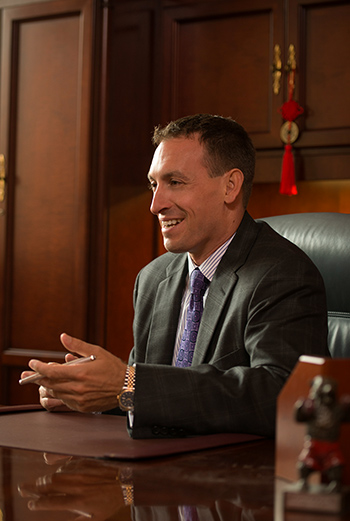Asset protection calls for active management
Asset protection calls for active management

Sequinox • J.W. Cole Advisors, Inc.
When it comes to investing, Joe Wirbick is not shy about his convictions. His call to action is loud and clear: asset protection, asset protection, asset protection. Utilizing third-party managers and educating his clients about active investment strategies is first in his arsenal of defense.
I will never forget that in the eighth grade I told my teacher on a field trip that one day I was going to buy a commercial building like the ones we were driving by. You know what? I recently just bought the property our offices are located in.
This sort of defines the essence of my investing philosophy. I believe in multiple streams of income and in being well-diversified. It’s also important to be proactive—not to just sit idly by watching things happen when action should be taken.
I feel blessed to have received some excellent training early in my career working for major financial-services organizations. But my beliefs have evolved greatly over the years. I have some very definite ideas and have developed my own arsenal of financial solutions for clients.

It may be controversial to say, but I think a lot of advisors subtly mislead clients by saying they are managing their money for them. Most of us spend the bulk of our time working with current clients on their specific needs, finding the right solutions to various issues, educating, and prospecting. It is a rare advisor who can spend the day closely following the financial markets.
I do not think parking client money in a variety of mutual funds is really managing money. I think it makes much more sense to employ the services of an entire investment team with the skill and training to handle billions of dollars. They are professionals dedicated to doing that and nothing else.
It is a whole different world—like night and day versus the old asset-allocation methods. These managers have strategies that do not just go long the market like most traditional funds, but can go to cash at any time or go short in a down market.
Did you ever really hear of major institutions telling their clients to sell when markets were plummeting? No, they tell them to hold on and wait it out—no matter how bad it gets. Being down 30%-35% in 2008 is not doing the best job for clients, in my opinion. Not losing significant money in that kind of environment is the goal. That is the difference between a buy-and-hold approach and active management.
 For a new client or prospect, I ask them what sort of protection they have for their portfolio. The answer is almost always one of three things: “I have none,” or “I don’t know,” or “I don’t have any money in stocks.”
For a new client or prospect, I ask them what sort of protection they have for their portfolio. The answer is almost always one of three things: “I have none,” or “I don’t know,” or “I don’t have any money in stocks.”
For obvious reasons, none of those answers is acceptable. It is a pretty easy and persuasive argument why all or part of their life savings should not be exposed to markets without some measure of risk management. How much can they stand to lose? Most will say very little, and that leads naturally into a discussion of their individual risk profile.
My tendency is to use a combination of solutions for clients whenever appropriate—that might be some combination of indexed life, indexed annuities, and actively managed strategies.
With the active management portion of the portfolio, the third-party money managers we work with have done well in all sorts of market environments. Active money management is not designed to beat the market during strong upturns, and I tell clients that point blank. But when the market is down, clients will appreciate the protection it can provide. If we can outperform during down years, active management should provide meaningful returns over the long term. It is not about winning the inning, but winning the game.
Each element of a well-designed portfolio will likely have different performance characteristics during different types of market environments—up, down, sideways. The idea is to have this diversification working to the client’s benefit regardless of how the overall markets are doing.
We all know past performance is not indicative of future performance. But the track record of our active money managers in such a comparison exercise is very compelling. Aside from the flexibility these managers have for allocations into or out of the market, they also use a variety of asset classes: equities, fixed income, commodities, or currencies. It is eye-opening for clients to understand that they do not have to be limited to a long-only strategy or just one or two asset classes.
We take a great deal of pride in differentiating our firm by working with tax issues. If we are doing everything in our power to develop sound risk-management practices for portfolios, shouldn’t we also be providing investment strategies that are as tax effective as possible?
Our firm has shown tremendous growth over the years, and I attribute that largely to the emphasis we place on client education. Explaining concepts such as active management as thoroughly and as simply as possible to the average person is critical to developing shared expectations and having satisfied clients over the long run.
Disclosure: Joe Wirbick is a Registered Representative of J.W. Cole Financial, Inc. Securities offered through J.W. Cole Financial, Inc. (JWC), member FINRA/SIPC. Advisory Services offered through J.W. Cole Advisors, Inc. (JWCA). Sequinox and JWC/JWCA are unaffiliated entities.
Since 2020, advisory services offered through Mulholland Wealth Advisors (MWA). Sequinox and MWA are unaffiliated entities.
Photography by Jeremy Hess

